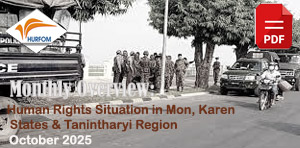Plantations abandoned and peace of mind lost after 5th villager wounded by landmine in Kyaung Shar Kwin area since October
May 3, 2019
On April 23rd 2019, Daw Hnin Se, a 63-year-old woman from the Kyaung Shar Kwin area, near Alae Sakhan village, Yebyu Township, Tenasserim Region, lost the large toe on her left foot when she stepped on a landmine while harvesting betel nuts. The woman was admitted to Dawei General Hospital following the incident but has since relocated to Yangon General Hospital with the financial support of area residents.
“It’s [betel nut] harvesting season, so many people are currently working on plantations. Daw Hnin Se has to do this work every day to make a living. She stepped on a landmine while she was working and lost her toe,” said U Tin San, the administrator of Alae Sakhan village.
Since October 2018, HURFOM has documented seven separate landmine blasts on or close to plantations in Yebyu Township, Mon state. In an effort to protect civilians in this region, the Mines Advisory Group (MAG) has undertaken to educate locals to recognize, avoid, and report such threats to MAG community liaison staff.
“MAG educated us about what to do after stepping on a landmine. We’ve requested the group to carry out a second training. But, just educating people will change nothing…what we want is to eliminate landmines in our area. Only when there are no landmines can we return to our plantations to work. If the possibility of stepping on a landmine remains, we will not return to our plantations. We lose entire harvests because of this,” continued U Tin San.
According to villagers, betel nut plantations in the Kyaung Shar Kwin area have largely been abandoned due to fears of serious injury or death following blasts in October and November of 2018 that left four villagers wounded.
“I refuse to go to my plantation in Kyaung Shar Kwin. Plantation workers frequently step on landmines, so I had to abandon it. Now it’s the harvest season, and I suffer financial losses because I’m too scared to go to my plantation. Is it fair that villagers have to suffer like this? I want the authorities to solve this problem as soon as possible,” said U Wai, a plantation owner from Alae Sakhan village.
“After the previous landmine blasts, plantation owners stopped going to their fields. But now, some villagers have started to work on the plantations again, like Daw Hnin Se. Villagers thought there were no more landmines, but when things like this happen, villagers again fear returning to the plantations,” said the Alae Sakhan village administrator.
Being an area that falls under the mixed-control of the New Mon State Party (NMSP) and the Karen National Union (KNU), the Alae Sakhan village administrator reported the incident to the NMSP and the KNU, but went on to state that neither group have investigated the incident, and have shown little desire to eliminate the threat posed by landmines.
As with the seven blasts that have occurred since October 2018, it remains unclear who planted the landmine that wounded Daw Hnin Se.
In contravention of international norms, the International Campaign to Ban Landmines documented both the military and various ethnic armed organizations (EAOs) as having used landmines in 2017. Beyond the threat of indiscriminately maiming or killing civilians, landmines can impede social and economic development by preventing communities from fully utilizing their lands and resources, and prohibit internally displaced persons and refugees from returning to their rightful homes.
To eliminate the many and varied threats posed by landmines, it is imperative that the Burma Government sign, ratify, and implement the 1997 Mine Ban Treaty, and that the military and EAOs immediately end the production and use of antipersonnel mines, and engage in formal mine action efforts initiated by the Burma Government to identify and clear landmines, explosive remnants of war, and improvised explosive devices.
Comments
Got something to say?
You must be logged in to post a comment.



















































